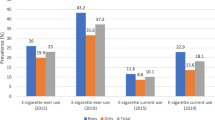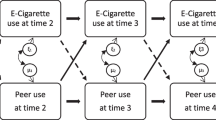Abstract
Purpose
Studies have shown consistent associations between youth e-cigarette use and subsequent smoking uptake. However, it remains unclear why, as limited evidence exists regarding the mechanisms underlying these associations. Our study investigated whether having one or more smoking friends mediated the association between e-cigarette use and cigarette smoking onset among a longitudinal sample of Canadian youth who were never smokers at baseline.
Methods
A longitudinal sample of youth that participated in three waves of the COMPASS study (2015–2016 to 2017–2018) was identified (N = 5,535). The product of coefficients method was used to assess whether having one or more smoking friends mediated the association between: (1) past 30-day e-cigarette use and cigarette smoking onset and (2) past 30-day e-cigarette use and subsequent dual use of e-cigarettes and cigarettes.
Results
Having one or more smoking friends did not mediate the association between (1) past 30-day e-cigarette use and cigarette smoking onset (β = 0.38, 95% CI − 0.12, 0.89) or (2) past 30-day e-cigarette use and subsequent dual use (β = 0.46, 95% CI − 0.16, 1.07). Post hoc tests indicated that smoking friends significantly predicted past 30-day e-cigarette use and cigarette smoking at wave 3 (aOR 1.68 and 2.29, respectively).
Conclusion
Having smoking friends did not explain the association between e-cigarette use and smoking uptake despite being a common risk factor for both e-cigarette use and cigarette smoking. Prevention efforts should consider how best to incorporate effective programming to address these social influences.

Similar content being viewed by others
Availability of data and materials
Data from the COMPASS study is not publicly available. Researchers interested in gaining access to COMPASS data must complete the COMPASS data usage application form (https://uwaterloo.ca/compass-system/information-researchers).
References
U.S. Department of Health and Human Service (2014) The health consequences of smoking—50 years of progress: a report of the surgeon general. Smoking Health. https://www.surgeongeneral.gov/library/reports/50-years-of-progress/full-report.pdf
Reid J, Hammond D, Tariq U, Burkhalter R, Rynard V, Douglas O (2019) Tobacco use in Canada : patterns and trends, 2019 Edition. Can Cancer Soc. https://www.tobaccoreport.ca/2013/TobaccoUseinCanada_2013.df
Montreuil A, MacDonald M, Asbridge M, Wild TC, Hammond D, Manske S et al (2017) Prevalence and correlates of electronic cigarette use among Canadian students: cross-sectional findings from the 2014/15 Canadian Student Tobacco, Alcohol and Drugs Survey. CMAJ Open 5(2):E460–E467. https://doi.org/10.9778/cmajo.20160167
Hammond D, Reid JL, Rynard VL, Fong GT, Cummings KM, McNeill A et al (2019) Prevalence of vaping and smoking among adolescents in Canada, England, and the United States: repeat national cross sectional surveys. BMJ. https://doi.org/10.1136/bmj.l2219
Zuckermann AME, Williams G, Battista K, de Groh M, Jiang Y, Leatherdale ST (2019) Trends of poly-substance use among Canadian youth. Addict Behav Rep 10:100189. https://doi.org/10.1016/j.abrep.2019.100189
Arrazola RA, Singh T, Corey CG, Husten CG, Neff LJ, Apelberg BJ et al (2015) Tobacco use among middle and high school students: United States, 2011–2014. MMWR Morb Mortal Wkly Rep 64(14):381–385
Health Canada (2019) Summary of results for the Canadian Student Tobacco, Alcohol and Drugs Survey 2018–2019. https://www.canada.ca/en/health-canada/services/canadian-student-tobacco-alcohol-drugs-survey/2018-2019-summary.html
Hammond D, Reid JL, Cole AG, Leatherdale ST (2017) Electronic cigarette use and smoking initiation among youth: a longitudinal cohort study. Can Med Assoc J 189(43):E1328–E1336. https://doi.org/10.1503/cmaj.161002
Aleyan S, Cole A, Qian W, Leatherdale ST (2018) Risky business: a longitudinal study examining cigarette smoking initiation among susceptible and non-susceptible e-cigarette users in Canada. BMJ Open. https://doi.org/10.1136/bmjopen-2017-021080)
Primack BA, Soneji S, Stoolmiller M, Fine MJ, Sargent JD (2015) Progression to traditional cigarette smoking after electronic cigarette use among us adolescents and young adults. JAMA Pediatr 169(11):1018–1023
Barrington-Trimis JL, Urman R, Berhane K, Unger JB, Cruz TB, Pentz MA et al (2016) E-cigarettes and future cigarette use. Pediatrics 138(1):e20160379–e20160379. https://doi.org/10.1542/peds.2016-0379
Leventhal AM, Strong DR, Kirkpatrick MG, Unger JB, Sussman S, Riggs NR et al (2015) Association of electronic cigarette use with initiation of combustible tobacco product smoking in early adolescence. JAMA 314(7):700–707
East K, Hitchman SC, Bakolis I, Williams S, Cheeseman H, Arnott D et al (2018) The association between smoking and electronic cigarette use in a cohort of young people. J Adolesc Heal 62(5):539–547. https://doi.org/10.1016/j.jadohealth.2017.11.301
Barrington-Trimis JL, Kong G, Leventhal AM, Liu F, Mayer M, Cruz TB et al (2018) E-cigarette use and subsequent smoking frequency among adolescents. Pediatrics 142(6):e20180486. https://doi.org/10.1542/peds.2018-0486
Best C, Haseen F, Currie D, Ozakinci G, MacKintosh AM, Stead M et al (2017) Relationship between trying an electronic cigarette and subsequent cigarette experimentation in Scottish adolescents: a cohort study. Tob Control 27:373–378
Conner M, Grogan S, Simms-Ellis R, Flett K, Sykes-Muskett B, Cowap L et al (2017) Do electronic cigarettes increase cigarette smoking in UK adolescents? Evidence from a 12-month prospective study. Tob Control 27:365–273
Khouja JN, Suddell SF, Peters SE, Taylor AE, Munafò MR (2020) Is e-cigarette use in non-smoking young adults associated with later smoking? A systematic review and meta-analysis. Tob Control. https://tobaccocontrol.bmj.com/content/early/2020/03/01/tobaccocontrol-2019-055433.abstract
Wills TA, Gibbons FX, Sargent JD, Schweitzer RJ (2016) How is the effect of adolescent e-cigarette use on smoking onset mediated: A longitudinal analysis. Psychol Addict Behav 30(8):876–886. https://doi.org/10.1037/adb0000213
Yuan M, Cross SJ, Loughlin SE, Leslie FM (2015) Nicotine and the adolescent brain. J Physiol 593(16):3397–3412
Counotte DS, Smit AB, Pattij T, Spijker S (2011) Development of the motivational system during adolescence, and its sensitivity to disruption by nicotine. Dev Cogn Neurosci 1(4):430–443
Vanyukov MM, Tarter RE, Kirillova GP, Kirisci L, Reynolds MD, Kreek MJ et al (2012) Common liability to addiction and “gateway hypothesis”: theoretical, empirical and evolutionary perspective. Drug Alcohol Depend 123(Suppl 1):S3–S17. https://doi.org/10.1016/j.drugalcdep.2011.12.018
Bandura A (1987) Social foundations of thought and action: a social-cognitive view. Acad Manag Rev
Liu J, Zhao S, Chen X, Falk E, Albarracín D (2017) The influence of peer behavior as a function of social and cultural closeness: a meta-analysis of normative influence on adolescent smoking initiation and continuation. Psychol Bull 143(10):1082–1115. https://doi.org/10.1037/bul0000113
Wellman RJ, Dugas EN, Dutczak H, O’Loughlin EK, Datta GD, Lauzon B et al (2016) Predictors of the onset of cigarette smoking: a systematic review of longitudinal population-based studies in youth. Am J Prev Med 51(5):767–778. https://doi.org/10.1016/j.amepre.2016.04.003
Azagba S, Kah K, Latham K (2019) Frequency of E-cigarette use and cigarette smoking among Canadian students. Prev Med. https://doi.org/10.1016/j.ypmed.2019.105769
Kong G, Morean ME, Cavallo DA, Camenga DR, Krishnan-Sarin S (2017) Sources of electronic cigarette acquisition among adolescents in Connecticut. Tob Regul Sci 3(1):10–16
Sussman S, Pokhrel P, Ashmore RD, Brown BB (2007) Adolescent peer group identification and characteristics: a review of the literature. Addict Behav 32(8):1602–1627
Leatherdale ST, Brown KS, Carson V, Childs RA, Dubin JA, Elliott SJ et al (2014) The COMPASS study: A longitudinal hierarchical research platform for evaluating natural experiments related to changes in school-level programs, policies and built environment resources. BMC Public Health 14(1):1–7
Qian W, Battista K, Bredin C, Brown KS, Leatherdale ST (2015) Assessing longitudinal data linkage results in the COMPASS study. Compass Tech Rep Ser. https://uwaterloo.ca/compass-system/publications#technical
MacKinnon DP (2008) Introduction to statistical mediation analysis. APA Handb Res methods Psychol Vol 2 Res Des Quant Qual Neuropsychol Biol
Sobel ME (1982) Asymptotic confidence intervals for indirect effects in structural equation models. Sociol Methodol 13:290–312
Greenland S, Pearce N (2015) Statistical Foundations for Model-Based Adjustments. Annu Rev Public Health 36:89–108. https://doi.org/10.1146/annurev-publhealth-031914-122559
Soneji S, Barrington-Trimis JL, Wills TA, Leventhal AM, Unger JB, Gibson LA et al (2017) Association between initial use of e-cigarettes and subsequent cigarette smoking among adolescents and young adults a systematic review and meta-analysis. JAMA Pediatr 171:788–797
Conner M, Grogan S, Simms-Ellis R, Scholtens K, Sykes-Muskett B, Cowap L et al (2019) Patterns and predictors of e-cigarette, cigarette and dual use uptake in UK adolescents: evidence from a 24-month prospective study. Addiction 114(11):2048–2055. https://doi.org/10.1111/add.14723
Azagba S (2018) E-cigarette use, dual use of e-cigarettes and tobacco cigarettes, and frequency of cannabis use among high school students. Addict Behav 79:166–170
Milicic S, Leatherdale ST (2017) The associations between E-cigarettes and binge drinking, marijuana use, and energy drinks mixed with alcohol. J Adolesc Heal 60(3):320–327. https://doi.org/10.1016/j.jadohealth.2016.10.011
Mehra VM, Keethakumar A, Bohr YM, Abdullah P, Tamim H (2019) The association between alcohol, marijuana, illegal drug use and current use of E-cigarette among youth and young adults in Canada: results from Canadian Tobacco, Alcohol and Drugs Survey 2017. BMC Public Health 19:108
Thomas RE, McLellan J, Perera R (2015) Effectiveness of school-based smoking prevention curricula: Systematic review and meta-analysis. BMJ Open 5(3):e006976
Macarthur GJ, Sean H, Deborah MC, Matthew H, Rona C (2016) Peer-led interventions to prevent tobacco, alcohol and/or drug use among young people aged 11–21 years: a systematic review and meta-analysis. Addiction 111(3):391–407. https://doi.org/10.1111/add.13224
Campbell R, Starkey F, Holliday J, Audrey S, Bloor M, Parry-Langdon N et al (2008) An informal school-based peer-led intervention for smoking prevention in adolescence (ASSIST): a cluster randomised trial. Lancet 371(9624):1595–1602
Funding
The COMPASS study has been supported by a bridge grant from the CIHR Institute of Nutrition, Metabolism and Diabetes (INMD) through the “Obesity – Interventions to Prevent or Treat” priority funding awards (OOP-110788; awarded to SL), an operating grant from the CIHR Institute of Population and Public Health (IPPH) (MOP-114875; awarded to SL), a CIHR project grant (PJT-148562; awarded to SL), a CIHR bridge Grant (PJT-149092; awarded to KP/SL), a CIHR project Grant (PJT-159693; awarded to KP), and by a research funding arrangement with Health Canada (#1617-HQ-000012; contract awarded to SL). The COMPASS-Quebec project additionally benefits from funding from the Ministère de la Santé et des Services sociaux of the province of Québec, and the Direction régionale de santé publique du CIUSSS de la Capitale-Nationale. Dr. Leatherdale is a Chair in Applied Public Health funded by the Public Health Agency of Canada (PHAC) in partnership with the Canadian Institute of Health Research (CIHR). Dr. Ferro holds the Canada Research Chair in Youth Mental Health and is supported by an Early Researcher Award from the Ministry of Research, Innovation, and Science. The funding sources noted above had no involvement in the study design, collection, analysis, interpretation of data, and writing of the report.
Author information
Authors and Affiliations
Corresponding author
Ethics declarations
Conflicts of interest
The authors have no conflicts of interest to declare.
Additional information
Publisher's Note
Springer Nature remains neutral with regard to jurisdictional claims in published maps and institutional affiliations.
Electronic supplementary material
Below is the link to the electronic supplementary material.
Rights and permissions
About this article
Cite this article
Aleyan, S., Ferro, M.A., Hitchman, S.C. et al. Does having one or more smoking friends mediate the transition from e-cigarette use to cigarette smoking: a longitudinal study of Canadian youth. Cancer Causes Control 32, 67–74 (2021). https://doi.org/10.1007/s10552-020-01358-1
Received:
Accepted:
Published:
Issue Date:
DOI: https://doi.org/10.1007/s10552-020-01358-1




